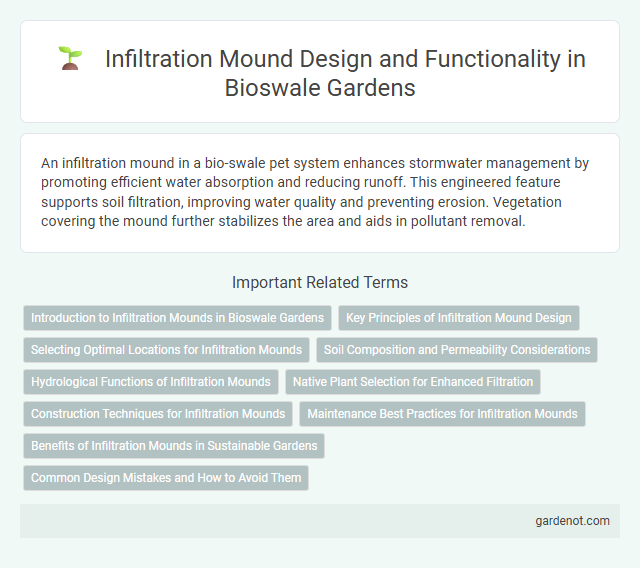An infiltration mound in a bio-swale pet system enhances stormwater management by promoting efficient water absorption and reducing runoff. This engineered feature supports soil filtration, improving water quality and preventing erosion. Vegetation covering the mound further stabilizes the area and aids in pollutant removal.
Introduction to Infiltration Mounds in Bioswale Gardens
Infiltration mounds in bioswale gardens serve as elevated soil structures designed to enhance stormwater absorption and promote groundwater recharge. These mounds increase surface area and improve water infiltration rates by slowing runoff flow within bioswales, reducing erosion and pollutant loads. Incorporating native, deep-rooted vegetation in infiltration mounds further supports soil permeability and sustains healthy bioswale ecosystems.
Key Principles of Infiltration Mound Design
Infiltration mound design relies on principles such as soil permeability, slope stability, and appropriate mound sizing to enhance stormwater infiltration and prevent surface runoff. Critical parameters include selecting well-draining soil media, maintaining a minimum separation distance from the seasonal high water table, and incorporating underdrains when natural infiltration rates are insufficient. Proper grading and vegetation promote erosion control and ensure the mound functions effectively within bio-swale systems for sustainable water management.
Selecting Optimal Locations for Infiltration Mounds
Selecting optimal locations for infiltration mounds requires analyzing soil permeability, underlying water table depth, and proximity to infrastructure to maximize stormwater infiltration and minimize contamination risks. Sites with well-drained soils, a minimum separation of three feet from the seasonal high water table, and adequate setback distances from building foundations and utilities enhance mound efficiency. Incorporating topographical assessments and land use compatibility further ensures sustainable integration within bio-swale stormwater management systems.
Soil Composition and Permeability Considerations
Infiltration mounds rely on carefully engineered soil composition to maximize permeability and enhance stormwater absorption. Optimal mixtures typically include sandy loam or loamy sand, which facilitate rapid infiltration while maintaining sufficient nutrient retention to support vegetation growth. Evaluating soil permeability rates, ideally between 0.5 and 2 inches per hour, ensures efficient water percolation without causing surface runoff or saturation issues.
Hydrological Functions of Infiltration Mounds
Infiltration mounds enhance stormwater management by increasing groundwater recharge and reducing surface runoff through soil absorption. Their engineered soil composition and vegetation promote efficient water infiltration, preventing erosion and filtering pollutants. These hydrological functions aid in mitigating urban flooding and improving water quality in surrounding ecosystems.
Native Plant Selection for Enhanced Filtration
Native plant selection for infiltration mounds is critical in maximizing pollutant removal and soil stabilization within bio-swale systems. Deep-rooted species such as switchgrass (Panicum virgatum) and blue flag iris (Iris versicolor) enhance water infiltration by increasing soil porosity and microbial activity, improving the filtration of stormwater runoff. Incorporating diverse native vegetation tailored to local climate and soil conditions optimizes nutrient uptake, reduces erosion, and supports long-term bio-swale performance.
Construction Techniques for Infiltration Mounds
Infiltration mounds are constructed using layered soil profiles designed to maximize water absorption through enhanced permeability and root zone integration. Key techniques involve selecting coarse sand and gravel substrates to facilitate rapid infiltration, combined with native vegetation planting to stabilize the mound and promote evapotranspiration. Proper grading ensures stormwater runoff is efficiently captured and evenly dispersed, preventing erosion and optimizing groundwater recharge within bio-swale systems.
Maintenance Best Practices for Infiltration Mounds
Regular inspection and removal of accumulated sediment and debris are essential for maintaining optimal infiltration rates in bio-swale infiltration mounds. Vegetation management, including periodic pruning and replanting of native species, supports healthy root systems that enhance soil permeability. Ensuring proper grading and avoiding soil compaction help prevent water runoff and promote effective groundwater recharge.
Benefits of Infiltration Mounds in Sustainable Gardens
Infiltration mounds enhance sustainable gardens by efficiently managing stormwater runoff and promoting groundwater recharge through natural infiltration processes. These mounds reduce soil erosion and minimize surface water pollution by filtering contaminants before water percolates into the ground. Integrating infiltration mounds with native vegetation supports biodiversity and contributes to healthier soil ecosystems in urban landscaping.
Common Design Mistakes and How to Avoid Them
Infiltration mounds often suffer from poor soil compaction, which reduces their ability to effectively absorb stormwater runoff and causes water pooling issues. Overlooking proper grading and underestimating the mound's size to handle peak flow volumes are frequent design mistakes that lead to overflow and structural instability. Ensuring well-graded slopes, using native soil with high permeability, and correctly sizing the mound based on watershed analysis significantly improve the bio-swale's infiltration performance and longevity.
Infiltration mound Infographic

 gardenot.com
gardenot.com